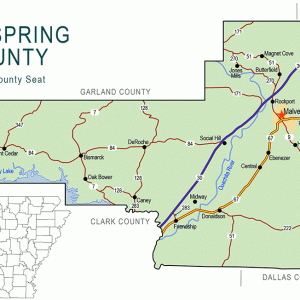calsfoundation@cals.org
Lambert (Hot Spring County)
Lambert is an unincorporated community in Hot Spring County located about two miles west of Bismarck (Hot Spring County). Accessed by Arkansas Highway 84, the community is closely tied to nearby DeGray Lake.
Early settlers include Riley Rowe, who obtained a federal land patent for 160 acres in 1875. Many members of the Rowe family lived in the area at the time of the 1880 federal census, but little information on Riley is available.
Carrie Lambert, wife of William Lambert, obtained 160 acres in 1883. Many Lamberts lived in the area, giving the community its name. Carrie and William were farmers and had no children. (She appears as Caraline in the census.) William served two terms in the Arkansas House and a single term in the Arkansas Senate. He also worked as an attorney. In the 1900 census, the couple had a twelve-year-old African American servant named Tom Reitan living in their home. The couple operated the farm, along with a cotton gin and grist mill. William died in 1908, and in the 1910 census, Carrie appears as a farm manager. She owned and operated the farm alone. Carrie died in 1918. Both William and Carrie are buried in Philippi Cemetery, located about five miles west of Lambert in Point Cedar (Hot Spring County).
Jeremiah Davidson obtained a federal land patent in the area for forty acres in 1885. Little information is available on Davidson. Charlie Counts acquired forty acres in 1914. In the 1920 census, he appears with his wife, Addie, and is listed as owning his farm.
The community was served by a number of schools. The Section Hill School operated in Lambert in the late nineteenth century. Efforts to create a high school led to the establishment of the Marcus School in 1906. Supported by William and Carrie Lambert, residents tore down the Section Hill School and constructed a two-story building, along with a house for the principal. The exact source for the name of the school is unknown, but one resident reported that Carrie Lambert named it in honor of her favorite store in Dallas, Texas—Neiman-Marcus. However, that store did not open until 1907. The adoption of the Marcus name led to the use of it rather than Lambert when referring to the community.
The high school operated on a subscription basis and offered classes only until about 1910. Grades first through eighth continued to be offered until the early 1920s, when a high school curriculum was reinstated. In the 1929–30 school year, Marcus consolidated with Bismarck, with a new brick building constructed in the community to house the expanded school. It operated as the Bismarck-Marcus School for several years before simply becoming the Bismarck School.
A post office operated at Lambert from 1909 to 1962. The original office operated from the home of Berry Lambert, the brother of William. Berry’s daughter Rosa Lambert served as the first postmistress. When full service ended, a rural station continued in operation until 1974. Service is now provided by the office in Bismarck. Several stores also served the Lambert community over the decades. Carrie Lambert operated a store in her home in the early twentieth century. Other businesses located in the community included blacksmith shops and a chair factory. Two doctors also served the community in the late nineteenth and early twentieth centuries. No businesses operate in Lambert in the twenty-first century.
Several cemeteries are in and near Lambert. The Forest Hill Cemetery is located north of Highway 84 and contains graves that date to 1883. Pleasant Hill Cemetery is located next to the Pleasant Hill Church of Christ and also contains graves that date to 1883. A newer cemetery is located on Highway 84 and honors the name of the former school in the community. Marcus Gardens includes graves that date to 1968. All the cemeteries continue to be active in the twenty-first century.
While population data for Lambert is unknown, it did serve as an important settlement in Hot Spring County, with political rallies held in the community. At an event hosted by William Lambert in 1903, Governor Jeff Davis and gubernatorial challenger Supreme Court justice Carroll Wood engaged in a fistfight during a campaign stop. The Hot Spring County sheriff arrested Wood, but the charges were later dropped. News accounts at the time placed the event in Bismarck, but later retellings put the incident in Lambert.
DeGray Lake is located immediately south of the community. The Oak Bower Recreation Area and Camp of the Pines, a former Presbyterian summer camp, are both located nearby. Lambert serves as a bedroom community for residents working in Hot Springs (Garland County) and other nearby towns.
For additional information:
Arsenault, Raymond O. The Wild Ass of the Ozarks: Jeff Davis and the Social Bases of Southern Politics. Knoxville: University of Tennessee Press, 1988.
“Historical Society Hears Talk on Lambert History.” The Heritage 4 (1977): 77.
“Marcus High School.” The Heritage 2 (1971): 64–65.
“Origin of Names.” The Heritage 5 (1978): 46–48.
Stanley, Bonnie Dixon. “Lambert, Arkansas.” The Heritage 38 (2011): 119.
Turner, Rosa Lambert. “She Smoked a Stone Pipe.” The Heritage 9 (1982): 155–160.
David Sesser
Southeastern Louisiana University
 Hot Spring County Map
Hot Spring County Map 




Comments
No comments on this entry yet.